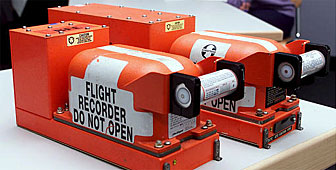
Crossair pilots tried to abort landing, recorders show

Flight recorders from the Crossair jet that crashed near Zurich, killing 24 people, have shown the pilots were aborting their landing attempt.
According to the cockpit voice recorder, the captain and commander of the aircraft, Hans Lutz, told air traffic controllers he would try a so-called “go around,” investigators said on Friday.
A “go around” would suggest that Lutz had abandoned efforts to land on runway 28. The crash occurred just after the pilot spoke of the “go around”.
Experienced pilot
In a post mortem examination, no traces of alcohol or drugs were found in the pilot’s bloodstream. Lutz was one of Crossair’s most experienced pilots, but he had recently switched to flying the model of aircraft involved in the crash.
Nine people survived the tragedy of flight LX3597 last Saturday evening. One of the survivors remains in a critical condition. The Jumbolino Avro RJ-100 from Berlin to Zurich, carrying five crew and 28 passengers, crashed in woodland just short of the runway.
Officials have refused to speculate on the cause of the tragedy, but visibility was poor, with rain and some snow. Initial reports indicated that the plane was flying too low.
Soft impact
“The recorder shows that it was a relatively soft impact,” said Jean Overney, head of the Office for flight accident investigations. “The airplane brushed the trees [before crashing] and that went on for a couple of seconds.”
Although the cause of the tragedy is unknown, new information came to light on Friday about the planned landing on runway 28. The crew were initially prepared to land on runway 14, which, unlike runway 28, is equipped with an instrument landing system (ILS) which gauges the aircraft’s altitude as it comes into land.
The flight recorder reveals that during the descent, about 20 minutes before the crash, the pilot was required to switch from a landing on runway 14, with a mechanically monitored gauge of altitude, to a landing on runway 28, which requires the pilot to manually gauge his altitude.
Runway 28 was recently introduced as a late night landing area at Zurich airport as part of an agreement between the Swiss and German governments to reduce noise pollution.
Investigators are still puzzled, however, as to why the aircraft was flying so low.
Engine failure ruled out
Marc Brunner, a member of the investigation team, told swissinfo that the recorders revealed no evidence of a major technical problem on board the aircraft, such as engine failure.
“The crew were very, very professional. They were not under stress when they said ‘go around’,” he said, indicating that the pilots were aborting the landing. “So it doesn’t look as if they really had a major technical problem, because if they had they surely would have reacted.”
The aircraft’s voice recorders also picked up an acoustic signal indicating that the automatic pilot was being switched off. But Brunner said it was impossible to say at this stage of the inquiry whether it was switched off by the crew or by the force of the impact.
Landing conditions revised
In response to the crash, Crossair has issued new conditions for landing on runway 28, which include a minimum of five kilometres horizontal visibility and a cloud level above 500 metres.
This compares with a 1,5 kilometre visibility requirement by the Federal Office for Civil Aviation.
Furthermore, a spokesman for Crossair added that landing would also not be permitted if there was any local obstruction from low level cloud or fog.
Crossair, a subsidiary of the ailing Swissair Group, is taking over parts of the Swissair operations in April 2002. A government-financed SFr1.45 billion bailout will keep Swissair planes flying until the takeover date.
The crash was the second in as many years for Crossair. A Saab340 headed to the German city of Dresden crashed shortly after takeoff from Zurich on Jan. 10, 2000, killing all 10 people on board.
swissinfo with agencies

In compliance with the JTI standards
More: SWI swissinfo.ch certified by the Journalism Trust Initiative


















![The four-metre-long painting "Sonntag der Bergbauern" [Sunday of the Mountain Farmers, 1923-24/26] had to be removed by a crane from the German Chancellery in Berlin for the exhibition in Bern.](https://www.swissinfo.ch/content/wp-content/uploads/sites/13/2025/12/01_Pressebild_KirchnerxKirchner.jpg?ver=1ea8acae)










You can find an overview of ongoing debates with our journalists here . Please join us!
If you want to start a conversation about a topic raised in this article or want to report factual errors, email us at english@swissinfo.ch.